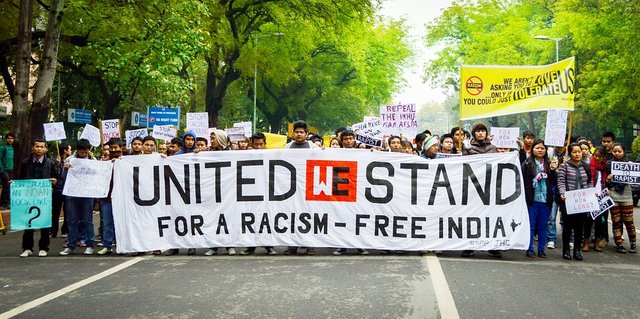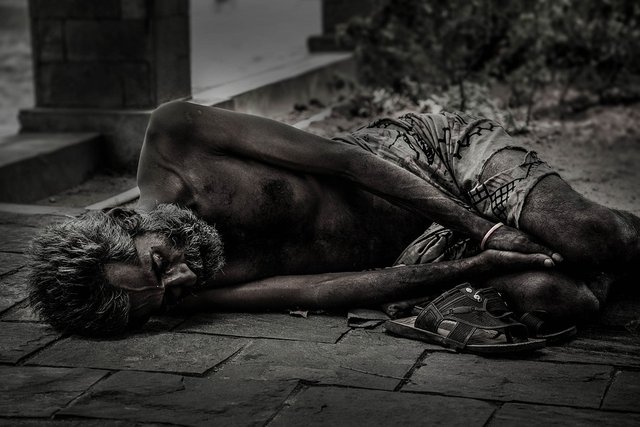Caste system in India.
During early Vedic period Indian society had a tribal form. It had primitive socialism type social structure. Gradually their society became complex which divided the society in three parts-Brahmans-the scholars and philosopher, Kshatriya-the warrior class and Vaishya-the business and artisan class. Later fourth Varna was added to the society which is known as Shudra-the labor and servant class. Description of shudra is in 10the sukta of the Rigveda which implies that it was added later.

These Varnas were based on the occupations. Inter Varna marriages were allowed in the beginning. Later it became difficult to marry outside their own Varna. It is said that Manu created this system to stop inter-breeding of different Varna people. Progeny of different Varna people were divided in different jatis i.e. castes. Every caste was given or had adopted a specific task or occupation for livelihood. Jatis began to form on occupations. It was impossible to marry outside one’s caste or jati. Brahmans are top caste which is revered and mainly consisted of scholars, gurus and philosopher class people. (However, an illiterate and uneducated son of a Brahman is still called a Brahman while a highly skilled and wise Sudra is still not respected much by some people.) Kshatriya, vaishya and shudra had hierarchy based occupations and status in the society. later, there formed upjati or sub-castes within a caste. It was not allowed to marry outside a sub-caste.
It is thought that this system was created to stop class struggle. Greek scholar Pluto had also proposed that one fourth part of the population should be made slave. Caste system of India created a hierarchical society which was divided in many strata, in which one part was not better than slaves. Each stratum of the society had a definite place and status in the society. Even within a caste, people were divided in sub-castes. One sub-caste had a higher status compared to the next and so on. In contemporary India, there are over 5000 caste present.
Shocking realities of Indian caste system
According to Manusmiriti (religious text written by Manu), first three Varnas are twin borne (dwijas) while shudras are impure. As per its laws, it was not a big crime to kill shudra while it was a heinous crime to kill a Brahmin, even if he had committed a heinous crime. Shudras were not allowed to name an upper caste person. It was not allowed them to own property, money and became educated.

Worst condition was of the people whose castes were declared untouchable. Untouchables were not allowed to touch a caste Hindu. They were not allowed to fetch water from village wells and cremate their dead relatives in the cremation places of upper castes. In a short their condition was worse than those black slaves who were traded by the white people in America.
Caste discrimination not only ostracized a big part of the working class but it also rendered them devoid of self-respect and confidence. Under British rule they were categorized as scheduled caste. Tribal were declared schedule tribe. After independence they were provided the reservation in government jobs and education institutions. However, many upper caste Hindus think reservation as a blot in India’s constitution. They don’t like a lower caste and former untouchable to become self-dependent. In some rural and semi-rural part of the country, they are still not allowed to fetch water from the public water supply. If a schedule caste groom rides a horse in these areas, he and his relatives are severally beaten. Still their women are treated as sex slaves by some people. Definitely, things have changed a lot but sick mentality of some people is still unchanged.

Caste based discrimination stems from the religious text and laws of Hindus. It is thought as a divine plan to divide people in social hierarchy. Religious text of Hindus says that every Varna has definite work. Doctrine of Karma was devised to fortify the canons of caste based discrimination. Lower caste people think that it was their past Karma which resulted in their present life’s miseries and sufferings. It made them lazy, fatalist and indifferent towards their own condition.
This caste based dissemination is not confined to Hindus only. Indian Muslims, Christians and Sikhs also practice casteism. Syrian Christians of Kerala consider themselves upper caste and they look down upon other Christians and treat them as untouchables. Condition of low caste Muslims and Christians is not much different from a low caste Hindu. This is the reality of caste system of India which divided people and sowed seeds of enmity and mutual hatred among them. In fact, casteism is the worst form of racial discrimination.
Racial discrimination is present in many parts of the world. However, caste based discrimination is unique in the world as it divides the people who are sharing and practicing the same racial and genetic characteristics, religion, language and region. It is a big blot on the face of India.
(All images sourced from pixabay.com)
This post has been rewarded with 100% upvote from @indiaunited-bot community account. We are happy to have you as one of the valuable member of the community.
If you would like to delegate to @IndiaUnited you can do so by clicking on the following links: 5SP, 10SP, 15SP, 20SP 25SP, 50SP, 100SP, 250SP. Be sure to leave at least 50SP undelegated on your account.
Please contribute to the community by upvoting this comment and posts made by @indiaunited.
Downvoting a post can decrease pending rewards and make it less visible. Common reasons:
Submit